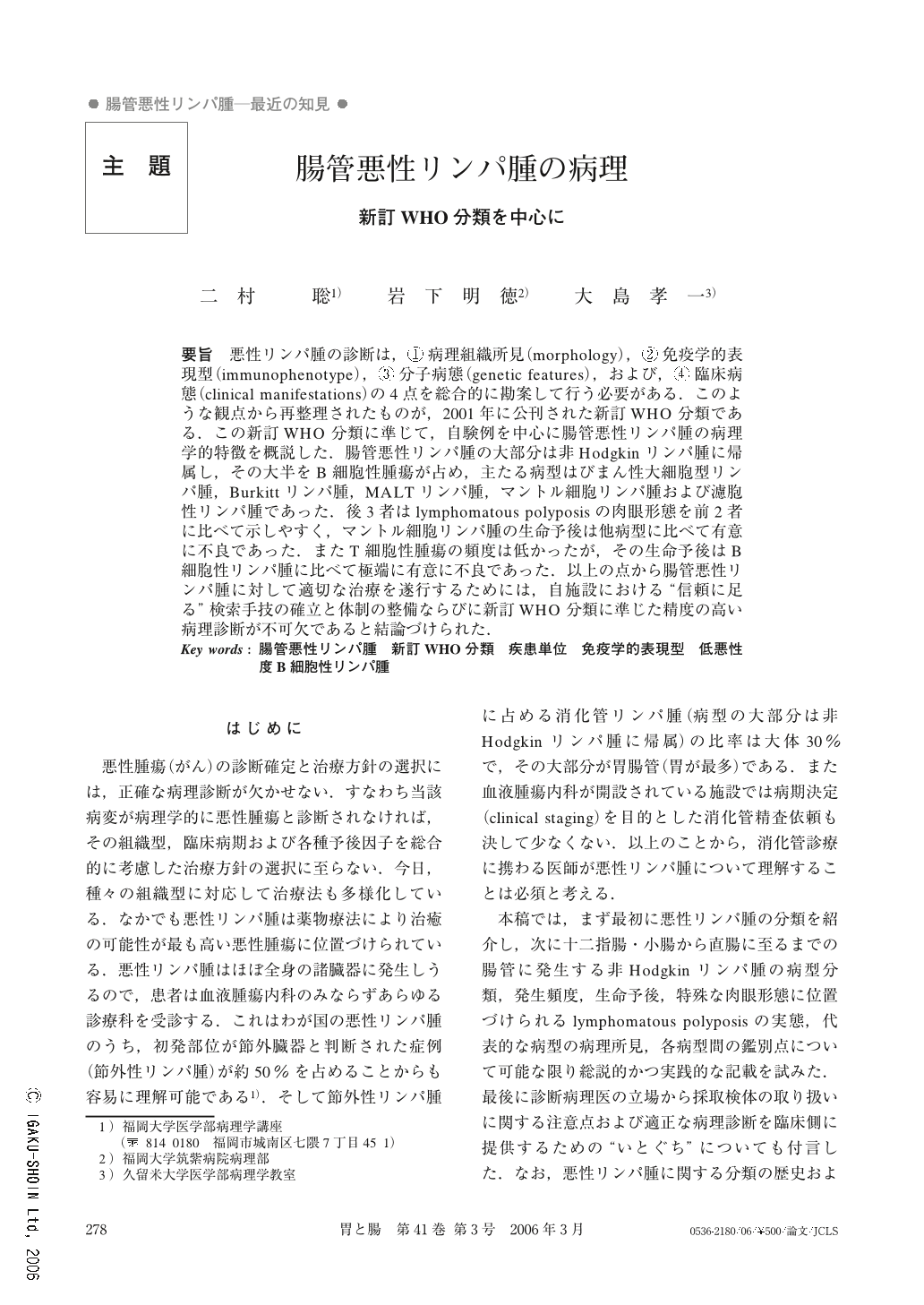Japanese
English
- 有料閲覧
- Abstract 文献概要
- 1ページ目 Look Inside
- 参考文献 Reference
- サイト内被引用 Cited by
要旨 悪性リンパ腫の診断は,①病理組織所見(morphology),②免疫学的表現型(immunophenotype),③分子病態(genetic features),および,④臨床病態(clinical manifestations)の4点を総合的に勘案して行う必要がある.このような観点から再整理されたものが,2001年に公刊された新訂WHO分類である.この新訂WHO分類に準じて,自験例を中心に腸管悪性リンパ腫の病理学的特徴を概説した.腸管悪性リンパ腫の大部分は非Hodgkinリンパ腫に帰属し,その大半をB細胞性腫瘍が占め,主たる病型はびまん性大細胞型リンパ腫,Burkittリンパ腫,MALTリンパ腫,マントル細胞リンパ腫および濾胞性リンパ腫であった.後3者はlymphomatous polyposisの肉眼形態を前2者に比べて示しやすく,マントル細胞リンパ腫の生命予後は他病型に比べて有意に不良であった.またT細胞性腫瘍の頻度は低かったが,その生命予後はB細胞性リンパ腫に比べて極端に有意に不良であった.以上の点から腸管悪性リンパ腫に対して適切な治療を遂行するためには,自施設における“信頼に足る”検索手技の確立と体制の整備ならびに新訂WHO分類に準じた精度の高い病理診断が不可欠であると結論づけられた.
The new WHO classification of hematological malignancies categorizes neoplasms primarily according to cell lineage : myeloid, lymphoid, histiocytic/dendritic cell and mast cell. Within each category, distinct diseases are defined according to a combination of morphology, immunophenotype, genetic features, and clinical manifestations. The gastrointestinal (GI-) tract is the most frequent site of extranodal non-Hodgkin lymphomas (NHLs). Most reported cases of primary GI-NHLs have been of gastric origin. To define the clinicopathological features of primary intestinal lymphomas, excluding those of gastric origin, in our study, 51 of 143 (35.7%) cases were situated in the ileocecal region, followed in decreasing order by the small intestine (n=49, 34.3%), the large intestine (n=25, 17.5%), and multiple sites (n=18, 12.6%). Immunophenotypically, 122 (85.3%) were of B-cell phenotype and 21 (14.7%) were of T-cell phenotype. With respect to immunophenotype, the survival rate for T-cell neoplasms was poorer than that for B-cell neoplasms. The most common B-cell neoplasm types were diffuse large B-cell lymphoma (n=84, 68.9%), Burkitt lymphoma (n=16, 13.1%), MALT lymphoma (n=10, 8.2%), and mantle cell lymphoma (MCL) (n=7, 5.7%). Patients of MCL had lymphomatous polyposis. Among the B-cell neoplasms, MCL tended to have a worse prognosis, whereas MALT lymphomas had a better prognosis than other neoplasms. Differential diagnosis between MCL and non-MCL (i. e. MALT lymphoma) is important to evaluate prognosis and the most suitable therapeutic regimen. Immunohistochemical studies play a key role in delineation of these entities.

Copyright © 2006, Igaku-Shoin Ltd. All rights reserved.


